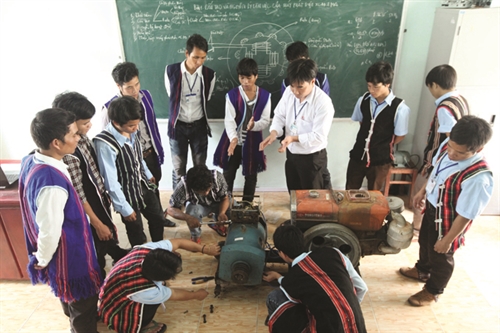Occupational safety had a gloomy year in 2015 when the number of work accidents and fatal work injuries both increased.
According to the Ministry of Labor, War Invalids and Social Affairs’ Department of Work Safety, 7,620 work accidents were reported last year affecting 7,785 workers, of whom 666 were killed and 1,704 injured.
 |
| A scaffolding collapse kills six persons on December 9, 2015, in Huong Son district, Ha Tinh province__Photo: Cong Tuong/VNA |
The figures all rose against last year with the number of accidents up 13.6 percent and the number of victims up 12.2 percent. Mortal injuries rose 5.7 percent and serious injuries, up 10.4 percent. The number of female victims also surged almost 14 percent.
Joint stock companies recorded the highest number of fatal workplace injuries, accounting for 40 percent of the total while foreign-invested joint ventures reported the lowest number with 1.2 percent. The largest number of death tolls was reported in the construction sector, making up nearly 38 percent of the total number of dead victims in work accidents.
Employers were mainly blamed for lethal injuries as nearly 53 percent of deaths in work accidents were due to their irresponsibility, including failure to adopt work safety processes and measures (accounting for over 25 percent of the total work accidents); unsafe equipment (14.3 percent); and failure to train employees in work safety (nearly 10 percent), the Phap Luat (Law) daily reported.
Although employees were responsible for only nearly 19 percent of occupational accidents, they committed serious faults such as violation of work safety process (over 17 percent) and failure to use personal safety devices (nearly 2 percent).
Work accidents caused serious losses to not only businesses and employees but the whole society. The country last year spent a total VND 153.97 billion for compensation, medicines and funeral costs for victims, the Phap Luat said. The total property loss was VND 21.96 billion and the total number of days off caused by work accidents was 99,679.
Experts agreed local governments’ and state management agencies’ delays in work accident investigation and reporting as well as lack of coordination in their settlement were reasons behind enterprises’ neglect in occupational safety.
Although occupational accidents increased last year, the number of enterprises reporting on work accidents declined, standing at 18,375 (nearly 7 percent) out of the total number of 265,009, over 1,400 less than last year, according to the Phap Luat.
Reporting on specific accidents was even worse. Last year saw 629 fatal work accidents but only 238 (38 percent) investigation reports were sent to the Ministry of Labor, War Invalids and Social Affairs by February this year.
Ha Tat Thang, general director of the Department of Work Safety told the Phap Luat these figures reflected enterprises’ neglect of work safety, saying just a few major businesses reported on work safety, making the evaluation of work accidents nationwide difficult.
The introduction of the Law on Occupational Safety and Health last year, which will take effect in July, is expected to help control and reduce work accidents as it widens occupational safety operations and specifies work safety-related rights and obligations of employers, employees and work safety officers.
It also establishes a stricter risk control system at various levels from workplaces and enterprises to state management agencies and related stakeholders, aiming to provide safer work environment and conditions.
Under the Law, employees have the right to request employers to ensure safe and clean working conditions and provide all information on dangerous and harmful elements at the workplace and prevention measures. They will also be trained in work safety and receive occupational health check-ups and healthcare. Particularly, employees may refuse to do jobs or may leave the workplace when noticing work accident risks and can still get paid.
To ensure fairness, the Law expands those entitled to work safety assurance to free employees who work without a work contract or are self-employed. The number of these workers now stands at 36 million out of the total 53 million employees nationwide.
The Law also metes out penalties for employers violating work safety regulations.
To make the Law come to life, work safety activities should be carried out frequently, Deputy Minister of Labor, War Invalids and Social Affairs Doan Mau Diep told the Phap Luat, citing work safety principles, measures to prevent dangerous and harmful elements and tackle technical incidents which might cause work unsafety, and assurance of occupational safety for particular employees. Diep said his ministry had tabled a national program for occupational safety and health during 2016-2020 to the Prime Minister for approval which will be implemented together with the Law.
Attention should be paid to building a culture of work safety at enterprises to prevent occupational accidents rather than merely settling them after their occurrence, Ha Tat Thang said, adding the risk assessment for working out prevention measures was crucial as well.- (VLLF)









